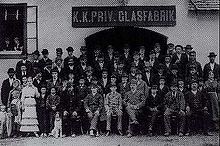Joh. Loetz widow
Joh. Loetz Witwe , also spelled Joh. Lötz Witwe , was an important art glass manufacturer in Klostermühle , Bohemia , Austria-Hungary . Loetz's works are among the most outstanding examples of Art Nouveau .
history
In the Wottawattal of the Bohemian Forest was one of the oldest glassworks, which was bought in 1850 by Johann Lötz , the founder of the company and former owner of the Deffernik, Hurkental, Annatal and Vogelsang glass factories.
In 1879 Max Ritter von Spaun , a grandson of Joh. Lötz, took over the factory from his grandmother and continued it under the old company "Joh. Lötz Witwe".
The factory was already provided with a not insignificant grinding shop, because heavily cut crystal and cut-through enamel overlaid glass was produced here and the production of colored glass was not switched to until the 1860s.
Because of its purity and fiery colors, Lötz'sche glass has always been a specialty and was initially mostly obtained as raw glass from North Bohemian refineries, which refined it with painting and grinding. In view of the good reputation of glass, the company later switched to the production of specialties in luxury items. The company was the first in Austria to produce so-called baroque glass, objects with glass decorations. These products enjoyed great popularity, and because the company set up adequate painting in a timely manner. Sample stores were located in Vienna, Berlin, Hamburg, Paris, London, Brussels, Milan and Madrid and soon gave the products a global reputation.
The glass could artfully imitate all kinds of onyx, jasper, carnelian, malachite, lapis, the inlay glass, etc. The luxury glasses that emerged from the factory earned the highest awards. In the anniversary exhibition in 1888 one saw the "Kaiser Franz Josefs-Vase", designed by Hofrat Storck and made by the Lötz company in Grauonyx, the largest vase that had been blown out of glass until then. Most of the world's fairs were also presented with special products from the company and were awarded the highest honors, including the Grand Prix Paris 1889, Prix de Progrès and Honorary Diploma Brussels 1888 as well as the honorary diplomas from Vienna, Munich, Antwerp, Chicago, San Francisco, etc. .
Max Ritter von Spaun has received numerous awards for his services to the glass industry. In 1883 he was awarded the high distinction of being allowed to use the title of kk priv. Glass factory and the imperial eagle in the shield and seal. Furthermore, he was awarded the Knight's Cross of the Franz Josef Order in 1889, then the royal. Belgian Leopold Order and the Order of the French Legion of Honor.
Since 1880 Eduard Prochaska has acted as director and active employee. Sons and grandsons of the workers who were employed in the glassworks of Joh. Lötz were the trunk of the factory staff, proof of the good rapport between employer and worker.
Similar to the glasses from Louis Comfort Tiffany , Loetz was able to produce glasses with a phenomenal decor with metallic iridescent colored glasses at a very high level. The company had contacts with other manufacturers such as J. & L. Lobmeyr and E. Bakalowits Sons in Vienna as well as the Argentor works . Well-known artists with whom we worked were Josef Hoffmann , Koloman Moser and the Wiener Werkstätte . The high point of the collaboration happened in the years after 1900. The company was awarded at the world exhibition in Paris and received awards in Chicago and St. Louis.
The outbreak of World War I and the collapse of the monarchy brought difficult times for the company. The Second World War and the expulsion of the German-speaking population of Czechoslovakia, and thus a large part of the employees, meant the complete end of the company. Art Nouveau works by Joh. Loetz Witwe can be found in several museums and regularly fetch high prices at auctions.
literature
- Waltraud Neuwirth: Loetz Austria 1905-1918: Glass . Vienna 1991, ISBN 3-900282-27-7 .
- Helmut Ricke and others: Lötz: Bohemian Glass 1880-1940. Volume 1: Work monograph. Prestel, Munich 1989, ISBN 3-7913-0984-6 .
- Ernst Ploil, Toby Sharp: Lötz 1900. The Lötz glass factory at the Paris World Exhibition 1900, auction house im Kinsky (ed.), Vienna 2017, ISBN 978-3-9503753-2-9
Web links
Individual evidence
- ↑ a b c d e f g Joh. Lötz widow . In: Presented by the industrialists of Austria under the high protectorate of His K. and K. Highness of the Most Serene Archduke Franz Ferdinand (Hrsg.): Die Groß-Industrie Oesterreichs . Festival ceremony for the glorious fiftieth anniversary of the reign of His Majesty the Emperor Franz Josef I. Volume 2 . Leopold Weiss, Vienna 1898, II. Stone, clay, porcelain and glass industry, p. 178 .
- ^ E. Lebensaft, J. Mentschl: Spaun, Max (imilian) (II.) Frh. Von (1856–1909), manufacturer. In: Austrian Biographical Lexicon 1815–1950 (ÖBL). Volume 13, Verlag der Österreichischen Akademie der Wissenschaften, Vienna 2007–2010, ISBN 978-3-7001-6963-5 , p. 7 f. (Direct links on p. 7 , p. 8 ).
- ^ Susanne Fleischner: Johann Lötz widow and Wiener Werkstätten. (No longer available online.) In: Collection area glass from Art Nouveau and Art Déco - Part 6. Kunstmarkt Media, February 21, 2002, formerly in the original ; Retrieved June 26, 2011 . ( Page no longer available , search in web archives ) Info: The link was automatically marked as defective. Please check the link according to the instructions and then remove this notice.
- ↑ Jakub Siska: Noble glass from the Bohemian Forest: the history of the Lötz company. In: Panorama CZ. Český rozhlas, August 16, 2009, accessed June 26, 2011 .
Coordinates: 49 ° 8 ′ 36.1 ″ N , 13 ° 30 ′ 44.1 ″ E


